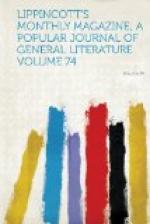Better even than La Boule is Tricoche et Cacolet, which is the name of a firm of private detectives whose exploits and devices surpass those imagined by Poe in America, by Wilkie Collins in England, and by Gaboriau in France. The manifold disguises and impersonations of the two partners when seeking to outwit each other are as well-motived and as fertile in comic effect as any of the attempts of Crispin or of some other of Regnard’s interchangeable valets. Is not even the Legataire Universel, Regnard’s masterpiece, overrated? To me it is neither higher comedy nor more provocative of laughter than either La Boule or Tricoche et Cacolet; and the modern plays, as I have said, are based on a study of life as it is, while the figures of the older comedies are frankly conventional. Nowhere in Regnard is there a situation equal in comic power to that in the final act of the Reveillon—a situation Moliere would have been glad to treat.
Especially to be commended in Tricoche et Cacolet is the satire of the hysterical sentimentality and of the forced emotions born of luxury and idleness. The parody of the amorous intrigue which is the staple of so many French plays is as wholesome as it is exhilarating. Absurdity is a deadly shower-bath to sentimentalism. The method of Meilhac and Halevy in sketching this couple is not unlike that employed by Mr. W.S. Gilbert in H.M.S. Pinafore and The Pirates of Penzance. Especially to be noted is the same perfectly serious pushing of the dramatic commonplaces to an absurd conclusion. There is the same kind of humor too, and the same girding at the stock tricks of stage-craft—in H.M.S. Pinafore at the swapping of children in the cradle, and in Tricoche et Cacolet at the “portrait de ma mere” which has drawn so many tears in modern melodrama. But MM. Meilhac and Halevy, having made one success, did not further attempt the same kind of pleasantry—wiser in this than Mr. Gilbert, who seems to find it hard to write anything else.
As in the Chateau a Toto MM. Meilhac and Halevy had made a modern perversion of Dame Blanche, so in La Cigale did they dress up afresh the story of the Fille du R’egiment. As the poet asks—
Ah, World of ours, are you so gray,
And weary, World, of spinning,
That you repeat the tales to-day
You told at the beginning?
For lo! the same old myths that made
The early stage-successes
Still hold the boards, and still are played
With new effects and dresses.
I have cited La Cigale, not because it is a very good play—for it is not—but because it shows the present carelessness of French dramatists in regard to dramatic construction. La Cigale is a very clever bit of work, but it has the slightest of plots, and this made out of old cloth; and the situations, in so far as there are any, follow each other as best they may. It is not really a play: it is a mere sketch touched up with Parisianisms, “local hits” and the wit of the moment. This substitution of an off-hand sketch for a full-sized picture can better be borne in a little one-act play than in a more ambitious work in three or four acts.




